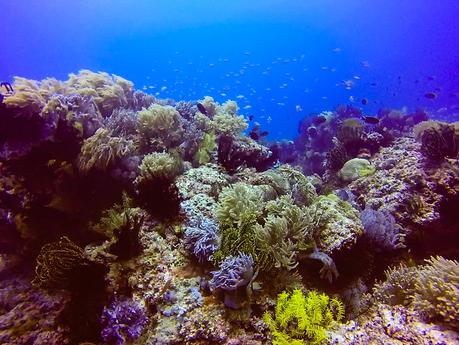
The first Camiguin Dive Festival poised the Island of Fire as an upcoming world-class dive destination. And it’s about time. Surrounded by crystal clear waters and magnificent reefs, and being a volcanic island, Camiguin has a lot of surprises when it comes to diving. We got a taste of Camiguin’s spectacular diving adventures at the magnificent Black Forest.
It was a 30-minute ride from Lambug beach to the Black Forest Dive site, which is near White Island. On the way, we admired the beautiful mountain scenery.
We reached the dive site, donned on our gear, listened to a safety briefing, and entered the water.
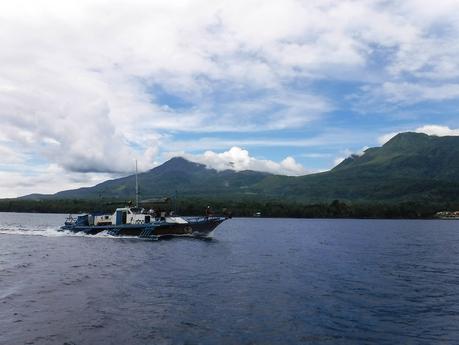
As we descended down to 30 feet, we saw that the Black Forest is part of a sandy slope that stretches from the shores of White Island into the depths of the sea surrounding Camiguin Island.
The hint of a healthy reef system was immediately evident after we saw huge patches of corals jutting up the slope. Let the adventure begin!
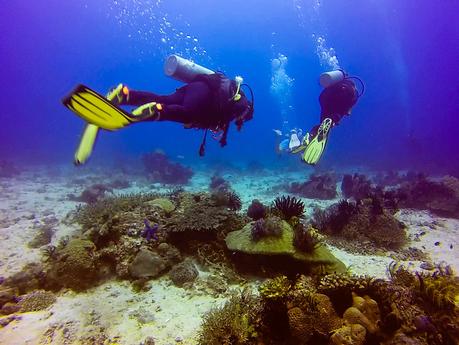
It may look like a long-discarded branch, but this is actually a type of coral called whip coral. Like many hard corals, whip corals are covered with tiny polyps. Depending on the zooxanthellae in the polyps, whip corals can be yellow, tan, orange, or deep purple.
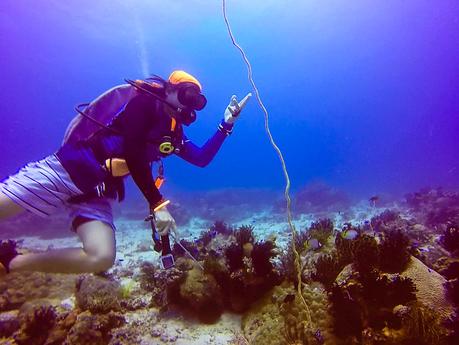
Sharp staghorn corals serve as a perfect hiding place for these small damselfish against these big huge creatures emitting bubbles. Because they are some of the fastest-growing hard corals in the world, they are perfect candidates for coral farming to replenish damaged reefs.
In one episode of Jonathan Bird’s Blue World, he visited a coral farm that “breeds” staghorn corals. The process and mechanism of the farm are really simple, and it can be applied here easily. You can check out the Coral Restoration Foundation site for more information about coral farming.
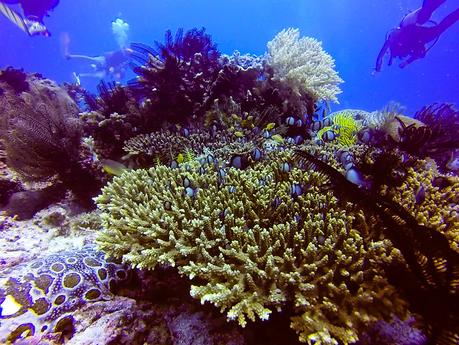
A healthy reef system is like a lively consortium of different organisms that are responsible for the well-being of the marine biosphere. In such a reef, corals and marine animals compete with each other for space.
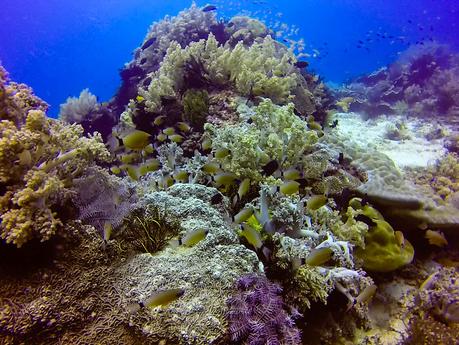
A highway of blue damselfish! It’s like a city down here!
Now, you might wonder why this dive site is named Black Forest. There were no black corals there, at least from a depth of 50 to 60 feet. The first time we encountered black corals was at a depth of more than 100 feet.
Well, it’s because black crinoids dominated the entire seascape. They’re like tufts of spiky hair growing on rocks and corals.
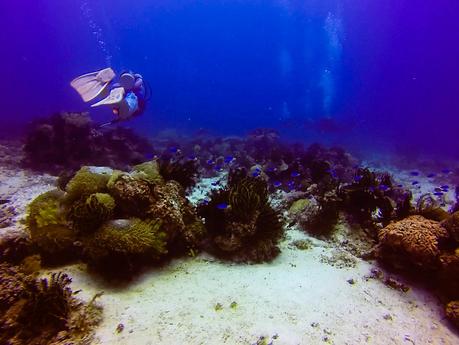
Crinoids, sometimes called feather stars, are spiky creatures related to starfish and sea urchins. At some point in their lives, crinoids are free-swimming creatures. But once they find a nice coral or a rock, they use a stem to attach themselves to the substrate.
Like an alien monster from the movies, adult crinoids have feeding arms, each covered with thousands of hair-like pinnules and covered with sticky mucus. They catch plankton and bacteria with their arms.
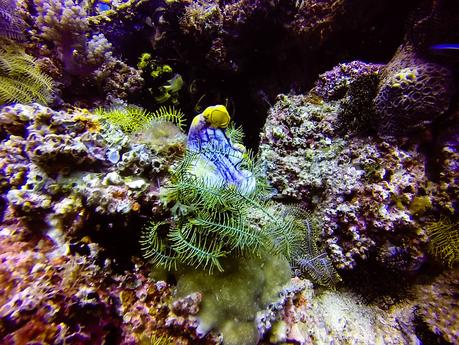
More crinoids on an elephant ear coral! Crinoids come in a variety of colors—black, yellow, purple, red, and more.
At the center of this assembly is a fan worm in full bloom! Sometimes called feather duster worm, it is a common marine organism in tropical waters. Its beautiful, flower-like appearance makes it a popular addition to saltwater aquariums.
Fan worms may be small, but they have an important role in removing organic particles to enhance the quality of water.
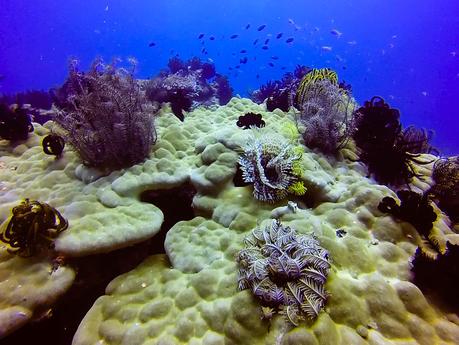
A crinoid decided to come with me. Do you want a crinoid for a pet? Hehehe!
(Video credit: Aleah Phils of Solitary Wanderer)
There are lots of hard corals here such as this enormous brain coral. Hard corals, or stony corals, build an external skeleton. Corals are actually a collection of tiny individual animals called polyps. If you look at a polyp under a microscope, it would look like a cylinder topped by a series of tentacles surrounding a mouth.
Polyps secrete calcium carbonate to protect their soft bodies. This calcium carbonate solidifies into the visible coral that we see.
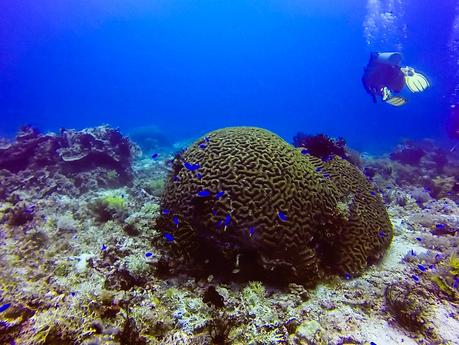
Soft corals, on the other hand, such as these carnation corals do not have a hard exoskeleton. They “dance” gracefully along with the current. Because they are quite attractive and they come in pastel colors, they are also collected by reef aquarium hobbyists.

Xeniidae is another family of lovely soft corals. Their cerates—small feeding tentacles at the tip of their stalks—close and open rapidly, making them appear as if they’re glittering. Vulnerable juvenile fish usually stay close to these corals for protection. However, these corals are not safe from certain species of sea slugs that eat them.
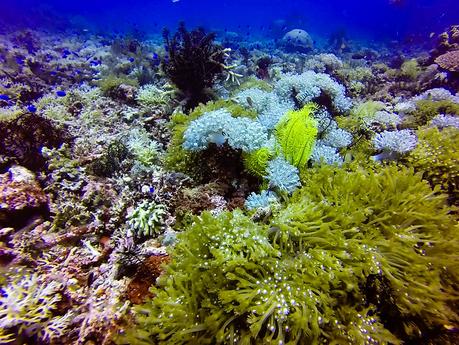
You can’t talk reefs and scuba diving if you don’t include the ubiquitous, colorful clownfish and its anemone home. Both mutually benefit from each other by protecting each other from predators.
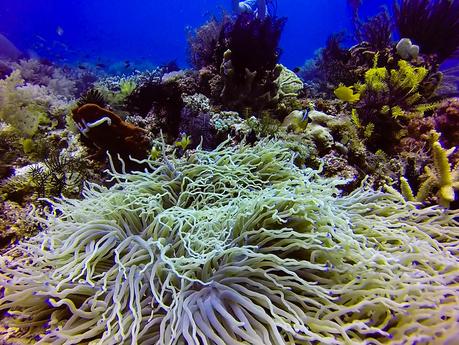
Giant barrel sponges are filter feeders. Seawater is continually filtered into the sides of the sponge and ejected out at the top. While doing so, small pores and sticky flagellae (microscopic tentacles) in the body filter out plankton and microscopic bacteria.
Check out this interesting video by Jonathan Bird on how a sponge works. It’s really super cool!
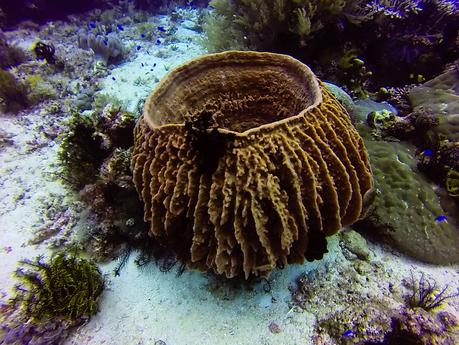
This barrel sponge has lots and lots of white sea cucumber around its body! Parasitism is a biological relationship wherein an organism (the parasite) lives on or in a host organism while causing harm to the latter. Many parasites are structurally and biologically adapted to certain hosts.
Looking at this makes me pity the barrel sponge. But that is nature, and parasitism is important to help maintain the balance of the ecosystem.
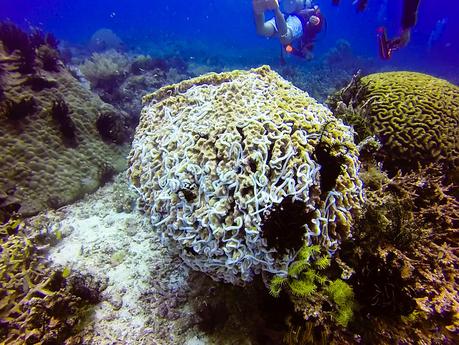
Lovely, isn’t it? The Philippines have some of the biggest, most diverse, and most beautiful reefs. They are all important not just for tourism but for the local economy. A healthy reef racks in millions of dollars in revenue.

Let’s check out some more interesting creatures residing in Black Forest. While hovering above the seafloor, we spotted a large rock moving. No, it wasn’t a rock! It was a large porcupinefish, perfectly camouflaged against the sandy seabed. We must have disturbed its nap. Hehehe!
A porcupinefish has two defense mechanisms. First, it can inflate its body by gulping water or air, swelling to two times its normal size. The sudden change in size scares away predators and discourages those with smaller mouths. Second, sharp spines along the fish’s body radiate outwards when inflated. Not exactly an easy prey, right?

In contrast to the camouflaged porcupine fish, this large varicosa nudibranch stood out in the open thanks to its bright colors. This nudibranch is toxic, and the vibrant colors are a means of telling predators, “Stay away from me! I don’t taste good!”
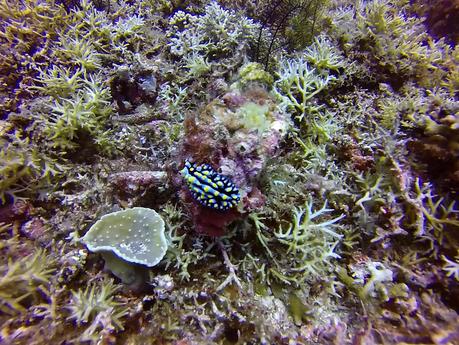
A large sea cucumber pointed its butt at me, ready to regurgitate its disgusting and sticky Cuvierian tubules for defense. These stringy, phlegm-like tubules entangle any creature that attempts to prey on a sea cucumber.
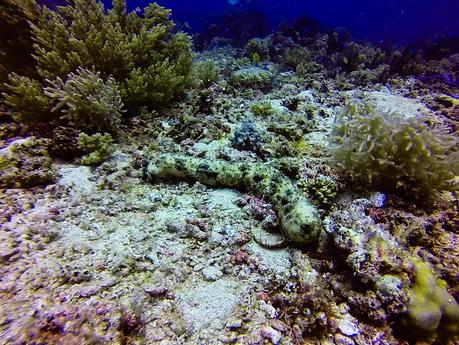
We didn’t expect this, but we were absolutely thrilled when we saw these graceful snakes. Black Forest turned out to be a have for graceful banded sea kraits. Banded sea kraits have a very distinctive appearance, with black and white stripes, a yellow snout, and a paddle-shaped tail
A semi-aquatic reptile, it goes to land to rest, digest its food, and reproduce. In the water, they are feared hunters and prey on fish and small eels.
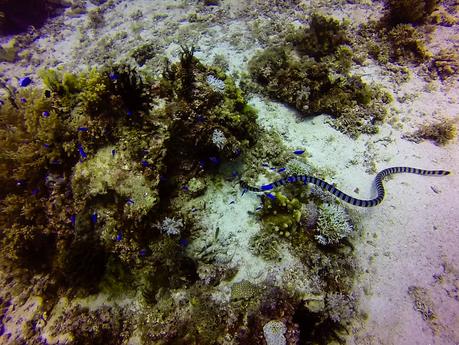
Banded sea kraits are some of the deadliest creatures on earth. They are armed with an incredibly neurotoxic venom that causes lethargy, paralysis, convulsions, fatal hypertension, and eventually death. In. Quick. Succession!
Fortunately, they are not aggressive; sea snake attacks only happen when they feel threatened. That’s why when we encounter wildlife, we always keep a safe and respectful distance away from them.
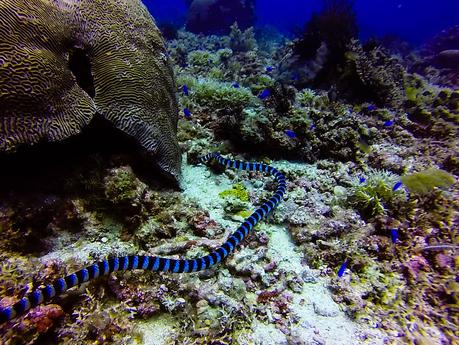
We also encountered this large school of striped eel catfish hunting for shrimp and crustaceans around the reef. They are also armed with strong venom, but they don’t attack divers.
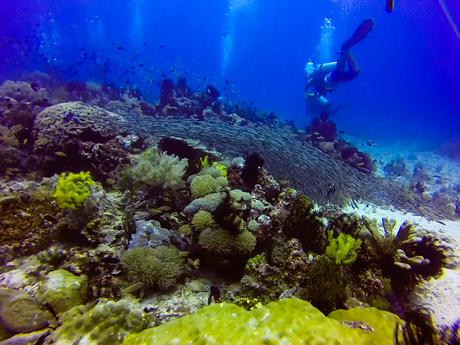
As what we always say, action speaks louder than static photos. So we made a short video of the action in Black Forest.
Our air supply was hovering on the red line, so it was time to head to shallow water to have a safety stop. While waiting for a few minutes before we can surface safely, we can’t help but admire the dive site. More so because Black Forest is located very near White Island, which is a frequently visited tourist destination.
Based on our experience, trash usually litter dive sites near popular tourist destinations. But Black Forest was a surprisingly pleasant exception. Throughout our 1-hour dive, we never saw any single piece of trash! How awesome is that!
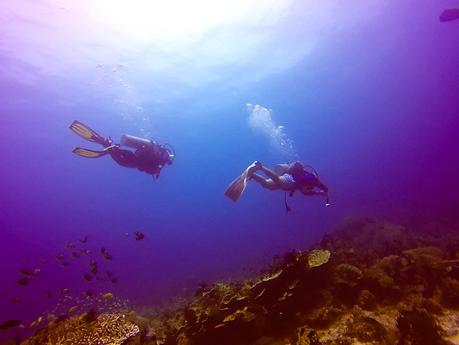
As we boarded our dive boat, we contemplated on our dive in the magnificent Black Forest. Camiguin may be a budding gem in the dive tourism industry, but the island certainly has stunningly pristine dive sites. The Camiguin Dive Festival has put Camiguin in an upward direction towards a coveted place as one of the top diving destinations in the country—and the world.
Camiguin is an island dotted by active volcanoes, giving it a unique characteristic. Following that notion, the reefs, rock walls, underwater caves, and ecosystems surrounding this island have their own unique surprises. We can’t wait to come back and explore more of Camiguin’s aquamarine waters!
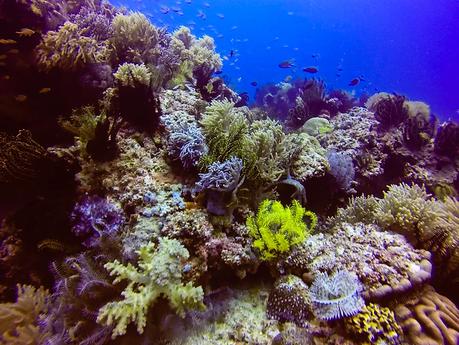
Contact Details
Click this link for more information about the Camiguin Dive Festival.
For more information about diving in Camiguin, get in touch with the tourism office using these contact details:
- Camiguin Tourism Facebook Page
- Email: [email protected]
- Phone number: 0917-706-0688
Going to Camiguin
Cebu Pacific and Philippine Airlines have direct flights to Camiguin from Cebu or Manila. Please check with their schedules.
Alternatively, you can take a ship or flight to Cagayan de Oro City. Head off to Agora Bus Terminal and take a bus or v-hire than will take you to Balingoan Pier. From there, you can ride a ferry that sails across the channel to Benoni Port in Camiguin. Check out our Camiguin, Island of Fire blog for more details.

